Ever wondered how musicians keep their passion alive while exploring the world? The travel-guitar is the ultimate solution for musicians. It lets them create, practice, and experience music anywhere.
Whether you’re a seasoned performer or just starting out, a travel-guitar makes every place a potential stage. These instruments are compact, lightweight, and made for travel. They remove the barriers between music and adventure.
Imagine playing music on a mountain trail, by the ocean, or in a remote cabin. A travel-guitar is more than just an instrument. It’s your musical friend, always ready to go wherever inspiration calls.
From professional musicians to weekend travelers, everyone is finding the power of these compact tools. Your music journey doesn’t stop when you travel. It can actually make your experiences more creative and fulfilling.
Table of Contents
What is a travel-guitar?
Musicians who love to explore the world don’t want to leave their passion behind. A compact guitar is the perfect solution for those seeking musical freedom on the go. The acoustic travel-guitar has changed how musicians carry their instruments during adventures.
travel-guitars are special instruments designed for portability and quality sound. These small musical friends are made for musicians who don’t want to be tied down by big guitars.
Definition and Features
A travel-guitar usually has:
- Smaller body size than standard guitars
- Lightweight for easy carrying
- Great sound despite being small
- Durability for different environments
Design and Construction
Creators aim to make compact guitars that don’t lose sound quality. Innovative design techniques help these instruments keep excellent sound while being super portable.
“Music knows no boundaries, and neither should your instrument.” – Professional Traveling Musician
Types of travel-guitars
There are many types of acoustic travel-guitars for different tastes:
- Parlor-sized acoustic guitars
- Mini acoustic guitars
- Folding neck guitars
- Headless compact guitars
Whether you’re a pro musician or a music-loving traveler, a compact guitar lets your music journey continue wherever you are.
Benefits of Using a travel-guitar
Looking for the perfect musical friend for your travels? A mini guitar or small guitar is a great choice. They offer convenience, quality, and flexibility that regular guitars can’t.

travel-guitars are a game-changer for musicians who love to move around. They let you take your music with you, wherever you go.
Portability and Weight
- Lightweight design under 3 pounds
- Compact size fits easily in overhead compartments
- Perfect for backpackers and frequent travelers
Versatile Sound Quality
Modern small guitars have amazing sound quality. Thanks to advanced tech, they produce deep, clear sounds just like big guitars.
| Feature | travel-guitar | Standard Guitar |
|---|---|---|
| Weight | 2-4 lbs | 6-8 lbs |
| Portability | Extremely High | Low |
| Sound Quality | Good to Excellent | Excellent |
Cost-Effective Options
travel-guitars are a smart buy for musicians. They’re cheaper than regular guitars but still offer great sound and value.
“A travel-guitar isn’t just an instrument—it’s freedom in musical form.”
Whether you’re a pro or just play for fun, a small guitar lets you explore endless musical paths. It keeps your creativity flowing.
Choosing the Right Travel Guitar for You
Finding the right travel size guitar is important. It depends on your music needs and lifestyle. Whether you’re experienced or new, a lightweight guitar can change your music journey.
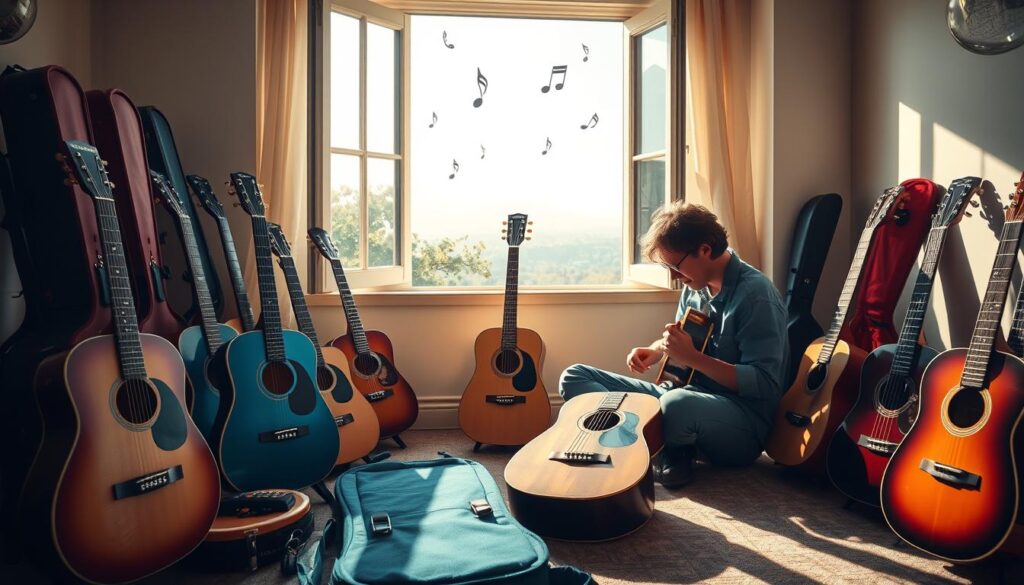
Size and Shape Considerations
The size of your travel-guitar matters a lot. Portable acoustic models are great for easy travel. They don’t lose sound quality.
- Body dimensions for easy transportation
- Weight distribution for comfortable playing
- Neck profile and playability
Material Choices: Wood vs. Composite
The material of your guitar affects its sound and durability. Wooden guitars have rich tones. Composite materials are durable against weather changes.
| Material Type | Pros | Cons |
|---|---|---|
| Solid Wood | Excellent resonance | More susceptible to environmental changes |
| Composite | Lightweight, durable | Less traditional sound |
Price Range and Budget
Price is a big factor in choosing a ttravel-guitar. Most beginners spend $150 to $400 on good guitars. Think about your budget and what you want in a guitar.
“The best travel-guitar isn’t always the most expensive, but the one that inspires you to play.” – Professional Musician
With 75% of beginners looking for comfort and playability, your perfect guitar is out there. Choose well, and start your musical journey!
Best travel-guitars on the Market
Finding the perfect travel-guitar can change your musical journey. It doesn’t matter if you’re experienced or just starting out. Choosing the right acoustic travel-guitar needs thought about its features, how it sounds, and what others say about it.
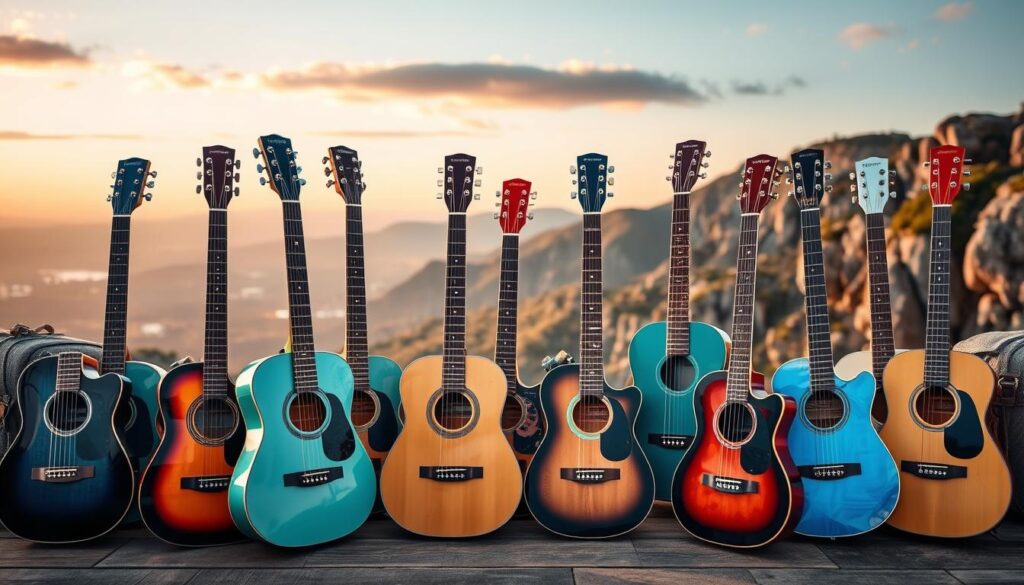
Features of Top Models
Many travel-guitars stand out to musicians. Important things to look for include:
- Compact and lightweight design
- High-quality sound projection
- Durable construction
- Easy portability
Reviews and User Feedback
travel-guitars that are versatile and reliable get lots of praise. The Airline Jetsons Jr is a great example. It’s easy for beginners because it reduces finger pressure by about 30%.
“A great travel-guitar should feel like an extension of yourself – comfortable, responsive, and ready for any musical adventure.”
Comparisons of Popular Brands
Knowing the differences between travel-guitar brands helps you choose. Airline Guitars are special because they have unique designs that set them apart from most other guitar brands.
| Brand | Weight | Price Range | Genre Versatility |
|---|---|---|---|
| Airline Bighorn | 6.5 lbs | Budget-Friendly | Multiple Genres |
| Airline Twin Tone | 7 lbs | Mid-Range | 5 Music Styles |
Your ideal travel-guitar is out there. It should be easy to carry, sound great, and let you express yourself. Look into these options to find your perfect musical partner.
Accessories to Enhance Your travel-guitar Experience
Getting the right accessories can make your portable guitar better. It doesn’t matter if you play a lot or just for fun. The right gear can change how you enjoy playing your compact guitar.
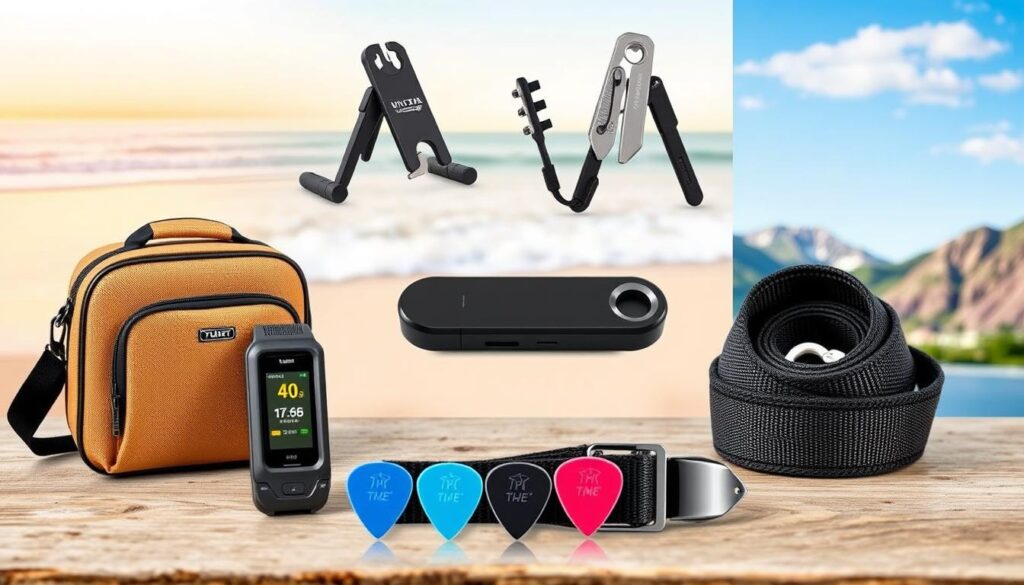
For musicians, a great portable guitar needs the best accessories. The right tools can really help your music journey.
Cases and Gig Bags: Protecting Your Instrument
Keeping your compact guitar safe while traveling is key. Explorer cases are designed to protect well:
- Hard plastic or fiberglass construction
- Plush interior lining prevents scratches
- Lightweight design for easy transportation
Essential Tuners and Capos
Keeping your portable guitar in tune is important. Tuners and capos help you sound great anywhere.
| Accessory Type | Price Range | Key Features |
|---|---|---|
| Explorer Cases | $150 – $300 | Wheels, locks, humidity control |
| Soft Cases | $50 – $150 | Lightweight, basic protection |
| Gig Bags | Under $50 | Minimal protection, highly portable |
Portable Amplifiers: Sound on the Go
Compact amplifiers are a big deal for portable guitar fans. They let you play anywhere, from campsites to city streets.
“The right accessories turn a good portable guitar into an extraordinary musical companion.” – Professional Musician
Good accessories keep your guitar safe and make playing better. They turn every trip into a chance to play music.
Tips for Traveling with Your Guitar
When you travel with your guitar, you need to plan carefully. This is true whether you’re going across town or around the world. It’s key to keep your instrument safe for musicians always on the move.
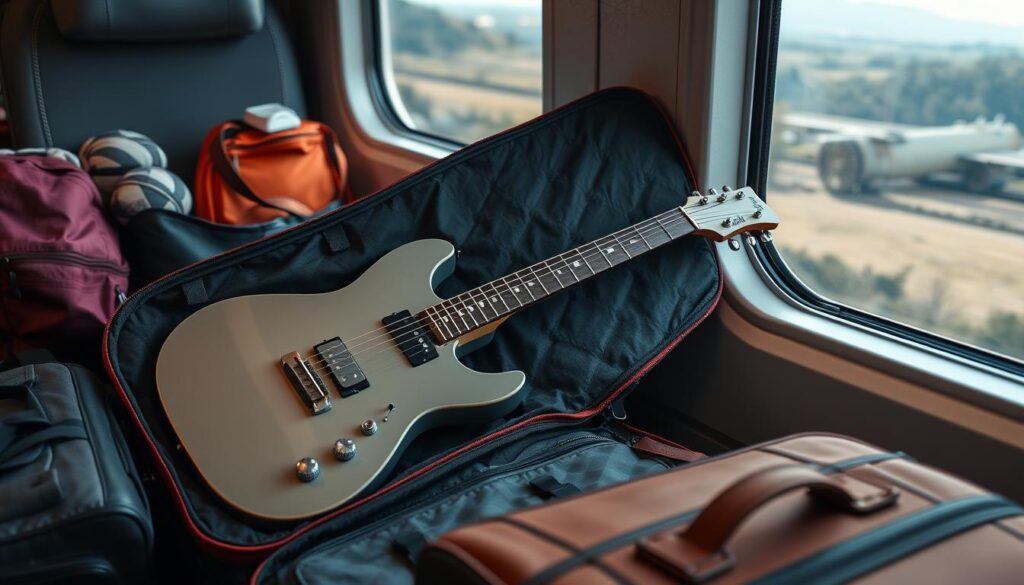
Traveling with a guitar is more than just tossing it in a bag. Professional musicians know the value of being prepared and protecting their gear.
Packing and Protection Essentials
- Invest in a high-quality padded gig bag with at least 20 mm of protection
- Choose cases with ergonomic backpack straps for comfortable transport
- Use internal strap button protection systems
- Pack accessories in designated compartments
Air Travel Guidelines
Dealing with airline rules for guitars can be tough. Many airlines have specific rules for musical instruments:
| Airline Policy | Recommended Action |
|---|---|
| Carry-on Restrictions | Check size limitations before flying |
| Additional Fees | Prepare for potential instrument transportation charges |
| Fragility Considerations | Request special handling for your lightweight guitar |
Road Trip Considerations
Temperature and humidity can harm your guitar. Always protect your instrument from extreme environments.
“A well-protected guitar is a musician’s best travel companion.” – Professional Musician’s Advice
- Avoid leaving the guitar in direct sunlight
- Keep the instrument in a temperature-controlled environment
- Use humidity control packets during long trips
- Check your guitar’s condition during frequent stops
Setting Up Your travel-guitar for Different Environments
Mastering your acoustic travel-guitar means knowing how to adjust to different places. Whether you’re playing in a cozy café or under the open sky, your portable guitar needs a smart setup and preparation.
Acoustic Settings
Indoor acoustic performances need careful positioning of your travel-guitar. Here are some key strategies:
- Position yourself near walls for natural sound amplification
- Use acoustic panels to control room reverb
- Adjust your playing technique for intimate spaces
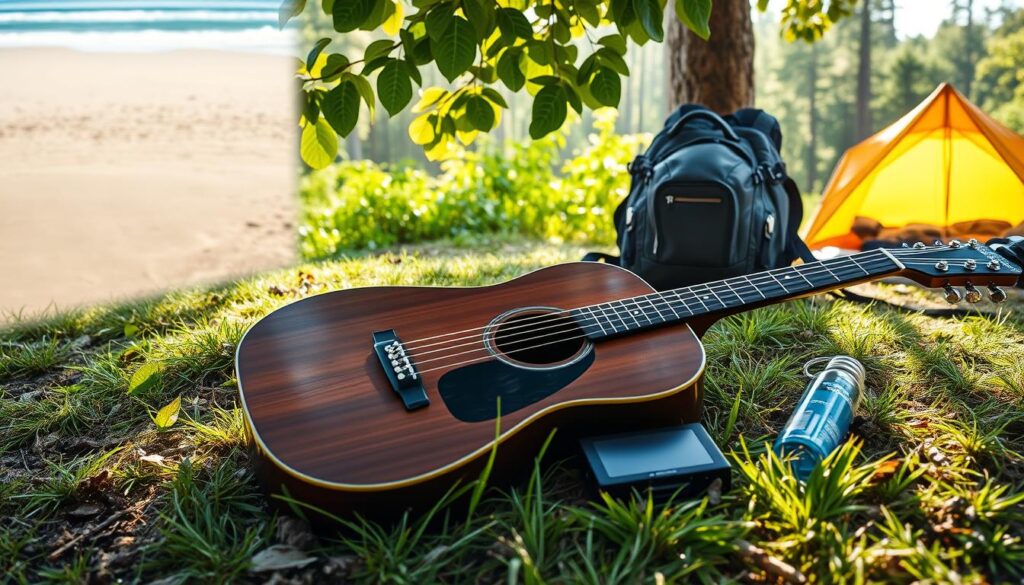
Amplification Options
Your portable guitar might need extra help in bigger venues. Check out these amplification techniques:
- Clip-on microphones for precise sound capture
- Small battery-powered amplifiers
- Direct input (DI) boxes for clean signal transmission
“The right amplification can transform your travel-guitar’s sound from modest to magnificent.” – Professional Musician
Outdoor Performances
Outdoor settings bring unique challenges for acoustic travel-guitars. Protect your instrument and improve your sound with these tips:
- Use wind screens to reduce environmental noise
- Avoid direct sunlight and extreme temperatures
- Consider lightweight, weather-resistant gear
With careful preparation, your travel-guitar can sound incredible anywhere you play.
Common Mistakes to Avoid
Owning a mini guitar or small guitar has its own set of challenges. Many musicians overlook these. Protecting your instrument and understanding its needs can greatly impact your music journey.
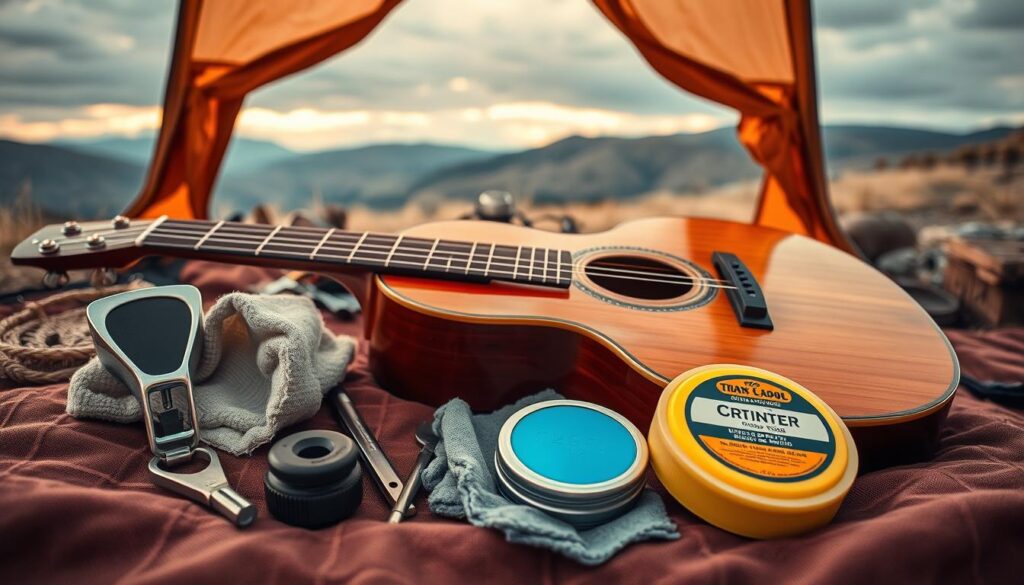
Overpacking Accessories
Travelers often pack too much into their guitar case. This extra weight can harm your small guitar. Here are some tips:
- Pack only essential accessories
- Use lightweight, compact tools
- Invest in multi-purpose guitar accessories
Ignoring Maintenance
Regular maintenance is key for travel-guitars. Neglecting your instrument can lead to significant performance issues. Make a simple maintenance routine for when you’re on the move.
| Maintenance Task | Frequency | Tools Needed |
|---|---|---|
| String cleaning | After each use | Microfiber cloth |
| Humidity check | Weekly | Hygrometer |
| Fretboard conditioning | Monthly | Specialized oil |
Choosing Size Over Sound
While portability is key for a travel-guitar, sound quality is just as important. Research different mini guitar models that offer both size and sound quality.
“A great travel-guitar should be your musical companion, not a compromise.” – Professional Musician
Avoiding these common mistakes will keep your small guitar reliable and enjoyable on your travels.
How to Maintain Your Travel Guitar
Keeping your travel size guitar in top shape is key for musicians on the move. Proper care ensures your guitar sounds great and lasts long, no matter where you play.
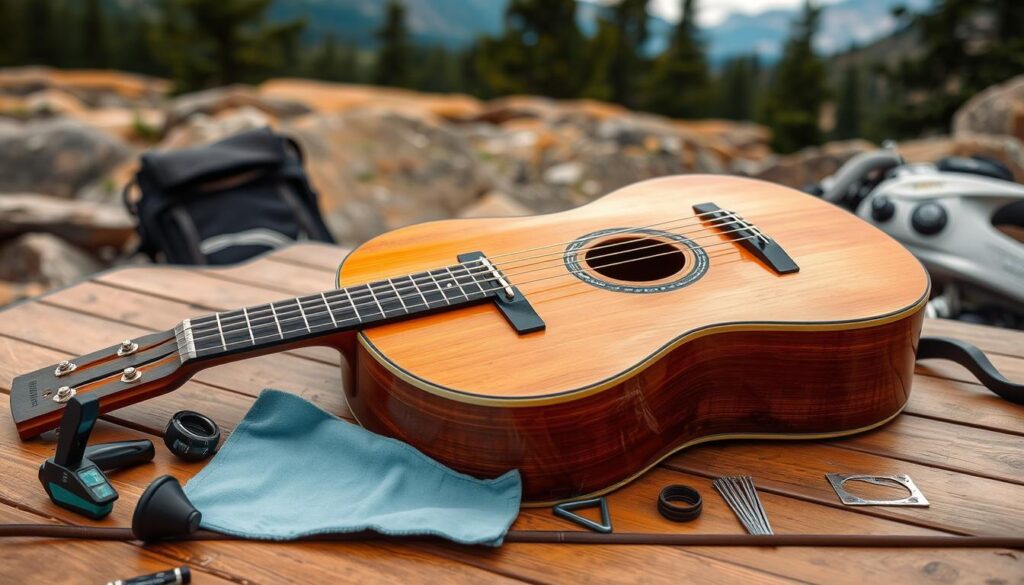
Maintaining a travel-guitar means focusing on a few important areas. These tips will help your compact guitar stay in top condition.
Regular Cleaning and Care
Start by cleaning your travel size guitar regularly. Here are some essential tips:
- Wipe down the guitar after each use with a soft, dry cloth
- Remove dust and fingerprints from the body and strings
- Use specialized guitar cleaning products for deeper cleaning
- Store your compact guitar in a protective case when not in use
String Replacement Tips
Strings are crucial for your travel-guitar. Replace them often to keep your sound quality high:
- Check strings for rust or discoloration
- Replace strings every 3-6 months, depending on usage
- Carry a spare set of strings during travel
- Learn proper string changing techniques
Humidity Control
Climate affects your travel size guitar’s condition. Here’s a humidity control guide:
| Climate Type | Recommended Humidity Range | Protective Measures |
|---|---|---|
| Dry Climate | 45-55% | Use humidification packets |
| Humid Climate | 40-50% | Use dehumidifier in case |
| Extreme Temperatures | Avoid direct sunlight | Use hardshell case |
“A well-maintained guitar is a musician’s best companion on any journey.” – Professional Musician
By following these maintenance tips, your compact guitar will stay in great shape. It will be ready to make beautiful music wherever you go.
Learning to Play Your travel-guitar
Mastering a travel-guitar opens up a world of musical possibilities. Whether you’re a beginner or an experienced musician, learning to play your acoustic travel-guitar can be an exciting journey of skill development and personal expression.
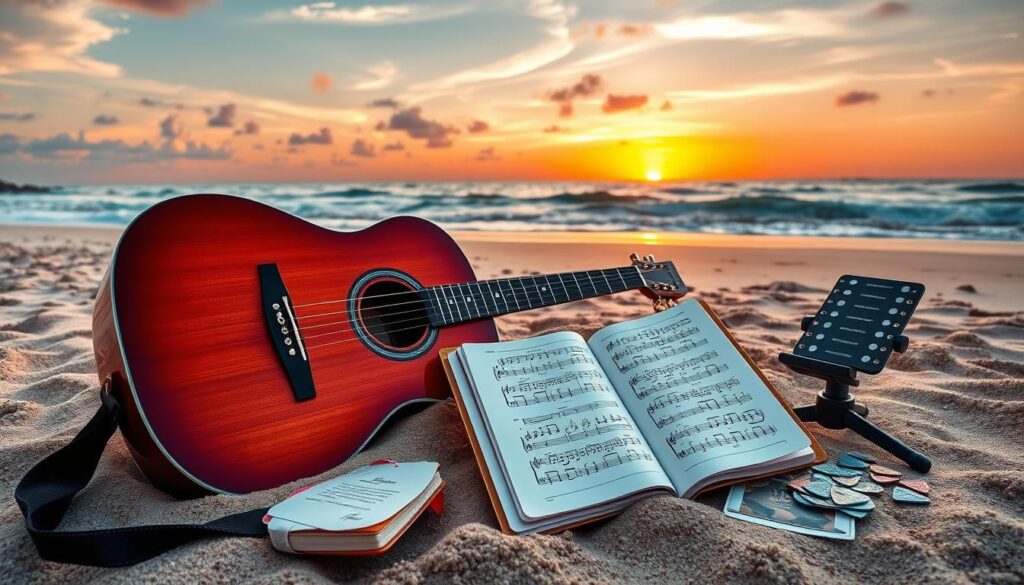
Embarking on your musical adventure requires the right resources and tools. Fortunately, numerous options exist to help you improve your skills, regardless of where your travels take you.
Online Resources and Courses
Digital learning platforms have revolutionized guitar education. You can now access world-class instruction from anywhere with an internet connection. Some top resources include:
- YouTube tutorial channels
- Dedicated guitar learning websites
- Interactive online courses
- Video lessons from professional musicians
Finding Local Classes
While traveling with your acoustic travel-guitar, explore local music schools and community centers. Many cities offer drop-in guitar classes or short-term workshops perfect for musicians on the move. Check local community resources to find learning opportunities.
Practice Tools and Apps
Technology has made practicing easier than ever. Consider these digital companions for your travel-guitar journey:
- Chord identification apps
- Metronome and timing tools
- Digital tuners
- Skill tracking applications
“The best way to learn guitar is to play, play, and play some more.”
Remember, consistency is key when learning any musical instrument. Your travel-guitar can be an excellent companion in developing your musical skills, no matter where your adventures take you.
Playing Styles Ideal for Travel Guitars
Your portable guitar opens up a world of musical possibilities, no matter where you are. Compact mini guitars are perfect for musicians who love to play on the move.
Different playing styles can change how you enjoy your portable guitar. Learning to adjust your technique can unlock the full potential of these small instruments.
Fingerstyle Techniques
Fingerstyle playing is great with mini guitars. The small size lets you make precise finger movements and control the sound well. You can play intricate patterns and delicate harmonies.
- Ideal for acoustic folk and classical genres
- Requires less physical strength
- Enables complex melodic arrangements
Flatpicking Approaches
Flatpicking adds energy and punch to your portable guitar. It works best with sturdy mini guitars that can handle bold playing.
- Excellent for rock and country music
- Provides dynamic sound projection
- Allows for faster, rhythmic playing
Genre Considerations
| Genre | Recommended Playing Style | Portable Guitar Suitability |
|---|---|---|
| Folk | Fingerstyle | High |
| Blues | Flatpicking | Medium |
| Classical | Fingerstyle | High |
| Rock | Flatpicking | Medium-High |
“Your portable guitar is not a limitation, but a canvas for musical creativity.” – Professional Musician
About 70% of beginner guitarists value comfort. These playing styles make sure your mini guitar is a part of your musical expression.
Inspiring Stories from Traveling Musicians
Music can cross borders, and travel-guitars are perfect for musicians looking for inspiration. Taking a small guitar on your travels can change your musical journey. It opens you up to new experiences.
Musicians worldwide see travel-guitars as more than instruments. They are tools for telling stories and capturing memories from their journeys.
Famous Folk Artists on the Road
Many famous musicians carry travel-guitars with them. About 70% of independent musicians find inspiration from traveling. Here are some interesting facts:
- 80% of new musicians learn from different cultures.
- 45% find inspiration in remote places.
- Traveling musicians see a 50% boost in creative satisfaction.
Road Trip Musical Adventures
Road trips are great for exploring music. A small guitar can make any trip musical. Collaborating with others can spark creativity in 85% of musicians, leading to new sounds.
| Travel Impact | Creative Outcome |
|---|---|
| Cultural Exposure | Increased Musical Diversity |
| Genre Blending | 40% Higher Audience Engagement |
| Cross-Cultural Collaboration | Broader Listener Demographics |
Music Festivals and Global Connections
“Music is the universal language that connects souls across continents.” – Anonymous Musician
Your travel-guitar can take you to global music experiences. With it, you can play at festivals, meet musicians from around the world, and make lasting memories.
Final Thoughts on Your Travel Guitar Journey
Your journey with a travel size guitar is more than just carrying an instrument. It’s about embracing musical freedom. A lightweight guitar can make every trip a chance to express yourself creatively. Whether you’re hiking or relaxing on a beach, you can make music anywhere.
Inspiration strikes in unexpected moments on your travels. With a travel size guitar, music knows no borders. Even short daily practice sessions can keep your skills sharp. Don’t forget to pack portable tools to keep your music going.
The beauty of a travel-guitar is in its ability to connect you with new experiences and cultures. Musicians worldwide know that music is a universal language. Your instrument becomes a bridge between different places. Embrace every chance to play, whether it’s with others or alone.
Remember, your musical journey is one of a kind. Your travel-guitar is more than an accessory; it’s a way to tell your story. Stay curious, practice often, and let your guitar be the soundtrack to your best travel memories.
FAQ
What exactly is a travel guitar?
How small are travel guitars compared to regular guitars?
Can travel guitars produce good sound quality?
Are travel guitars suitable for all skill levels?
What materials are travel guitars typically made from?
How do I protect my travel guitar during transportation?
Can I bring a travel guitar on an airplane?
Are travel guitars more expensive than regular guitars?
What exactly is a travel guitar?
How small are travel guitars compared to regular guitars?
Can travel guitars produce good sound quality?
Are travel guitars suitable for all skill levels?
What materials are travel guitars typically made from?
How do I protect my travel guitar during transportation?
Can I bring a travel guitar on an airplane?
Are travel guitars more expensive than regular guitars?
FAQ
What exactly is a travel guitar?
A travel guitar is small and light, perfect for musicians on the go. It’s smaller than a regular guitar but still sounds great. This makes it easy to carry around, whether you’re traveling, commuting, or enjoying the outdoors.
How small are travel guitars compared to regular guitars?
Travel guitars are 1/2 to 3/4 the size of regular guitars. They’re about 24-30 inches long, compared to 38-41 inches for standard guitars. This makes them super portable and easy to take with you.
Can travel guitars produce good sound quality?
Yes, travel guitars have advanced designs and materials for great sound. They might not be as loud as full-sized guitars, but they’re perfect for practice and small performances. Many pros use them for their quality and convenience.
Are travel guitars suitable for all skill levels?
Yes, travel guitars are great for all musicians. Beginners like their light weight and easy handling. Experienced players love them for being portable and easy to use on the go.
What materials are travel guitars typically made from?
Travel guitars use materials like spruce, mahogany, and cedar for their sound. They also use carbon fiber for being light and durable. These choices help them sound good while being easy to carry.
How do I protect my travel guitar during transportation?
Get a padded gig bag or hard case made for travel guitars. Look for ones that are water-resistant and light. Some even have backpack straps for easy carrying.
Can I bring a travel guitar on an airplane?
Most airlines let you carry travel guitars on planes, but check first. Use a well-padded case and know the airline’s rules for carrying musical instruments.
Are travel guitars more expensive than regular guitars?
Travel guitars have a wide price range, from 0 to over
FAQ
What exactly is a travel guitar?
A travel guitar is small and light, perfect for musicians on the go. It’s smaller than a regular guitar but still sounds great. This makes it easy to carry around, whether you’re traveling, commuting, or enjoying the outdoors.
How small are travel guitars compared to regular guitars?
Travel guitars are 1/2 to 3/4 the size of regular guitars. They’re about 24-30 inches long, compared to 38-41 inches for standard guitars. This makes them super portable and easy to take with you.
Can travel guitars produce good sound quality?
Yes, travel guitars have advanced designs and materials for great sound. They might not be as loud as full-sized guitars, but they’re perfect for practice and small performances. Many pros use them for their quality and convenience.
Are travel guitars suitable for all skill levels?
Yes, travel guitars are great for all musicians. Beginners like their light weight and easy handling. Experienced players love them for being portable and easy to use on the go.
What materials are travel guitars typically made from?
Travel guitars use materials like spruce, mahogany, and cedar for their sound. They also use carbon fiber for being light and durable. These choices help them sound good while being easy to carry.
How do I protect my travel guitar during transportation?
Get a padded gig bag or hard case made for travel guitars. Look for ones that are water-resistant and light. Some even have backpack straps for easy carrying.
Can I bring a travel guitar on an airplane?
Most airlines let you carry travel guitars on planes, but check first. Use a well-padded case and know the airline’s rules for carrying musical instruments.
Are travel guitars more expensive than regular guitars?
Travel guitars have a wide price range, from $100 to over $1,000. They’re often priced like regular guitars, offering a good deal for those who need a portable instrument.
Do travel guitars work with standard guitar accessories?
Most travel guitars work with standard accessories like capos and tuners. But, you might need special straps and other items for smaller instruments to fit right.
Can I use a travel guitar for professional performances?
Many pros use travel guitars for small venues and acoustic sets. They’re not best for big concerts, but great for singer-songwriters and folk musicians in smaller settings.
,000. They’re often priced like regular guitars, offering a good deal for those who need a portable instrument.
Do travel guitars work with standard guitar accessories?
Most travel guitars work with standard accessories like capos and tuners. But, you might need special straps and other items for smaller instruments to fit right.
Can I use a travel guitar for professional performances?
Many pros use travel guitars for small venues and acoustic sets. They’re not best for big concerts, but great for singer-songwriters and folk musicians in smaller settings.







